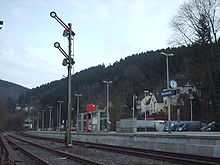Hagen-Rummenohl

Rummenohl, now officially Hagen-Rummenohl, is a locality within the independent city of Hagen in the eastern part of the Ruhr, in Germany. It was incorporated into Hagen in 1975 together with Dahl and Priorei.
The first element in the placename, rum- (Middle High German rummeln, rumelen; Danish rumle; Old Norse rumja = "to make noise") may indicate that in prehistoric times it was a location for fertility rites.
History
The former independent settlement of Dahl, consisting of Dahl, Priorei and Rummenohl, was incorporated in 1970 into the town of Breckerfeld in the district (Kreis) of Ennepe-Ruhr. In 1975, the Parliament of the state of North Rhine-Westphalia decided to transfer it to the metropolitan district of Hagen.
Industrial history
Rummenohl has for centuries been a centre of ironworking, using the power of the River Volme to process iron ore from the Siegerland. The opening on 16 March 1874 of the single-track Volmetal-Bahn, which made a connection for goods traffic to Brügge in Lüdenscheid and beyond that to Meinerzhagen, improved its integration into the developing Ruhr. Goods traffic to Lüdenscheid via Brügge was discontinued in early 1996.
In the early 1870s, Alfred Nobel founded a factory in Rummenohl to manufacture dynamite. On 5 June 1910 it was struck by lightning and exploded.
Beginning in 1908, gunpowder was manufactured in the valley of the Sterbecke, which flows into the Volme in Rummenohl. The company which owned the factory, Castroper Sicherheitssprengstoff ("Castrop Safety Explosives"), was known colloquially as 'Sprengstoff' or as Gelbe Hand ("Yellow Hand") because contact with the chemicals dyed the skin of one's hands yellow. In peacetime, 100 people worked there; during World War I, the number rose to over 2,000. In wartime, the factory primarily produced landmines, cartridges and charges for grenades; later, it once more produced explosives for road construction and mining. A spur railway connected the distant factory on the heights near Selkinghausen to the Volmetal-Bahn railway line, negotiating the difference in height by means of several switchbacks. Beginning in 1926, the factory was gradually closed down. After World War II, the buildings served as accommodations for bombing victims and refugees. The building was torn down in the 1960s in the course of construction of the A45 Autobahn.
In 1901 Hermann Dresel, a master baker born in Hülscheid, bought the old Post Office station in Rummenohl with his wife and founded the inn Pension Dresel, which has survived to the present day.
In 1918, a new church was built.
The grain mill and former smithy at Krummewiese, on the northern edge of Rummenohl, which had been in operation since 1824, was shut down in 1952.